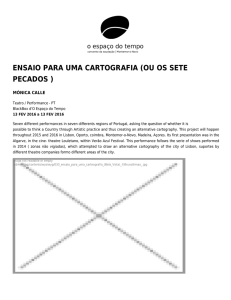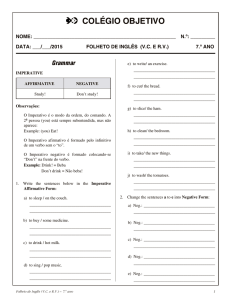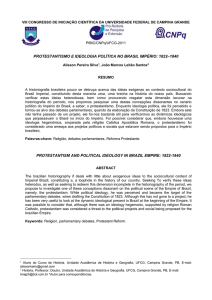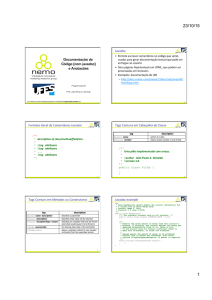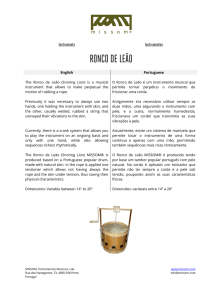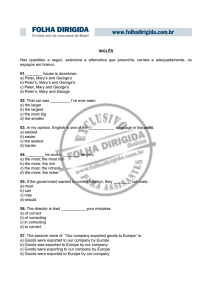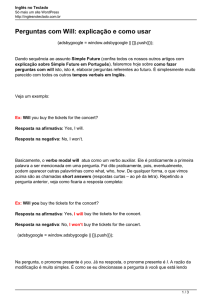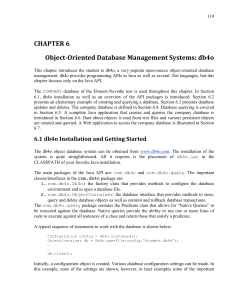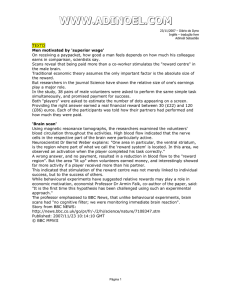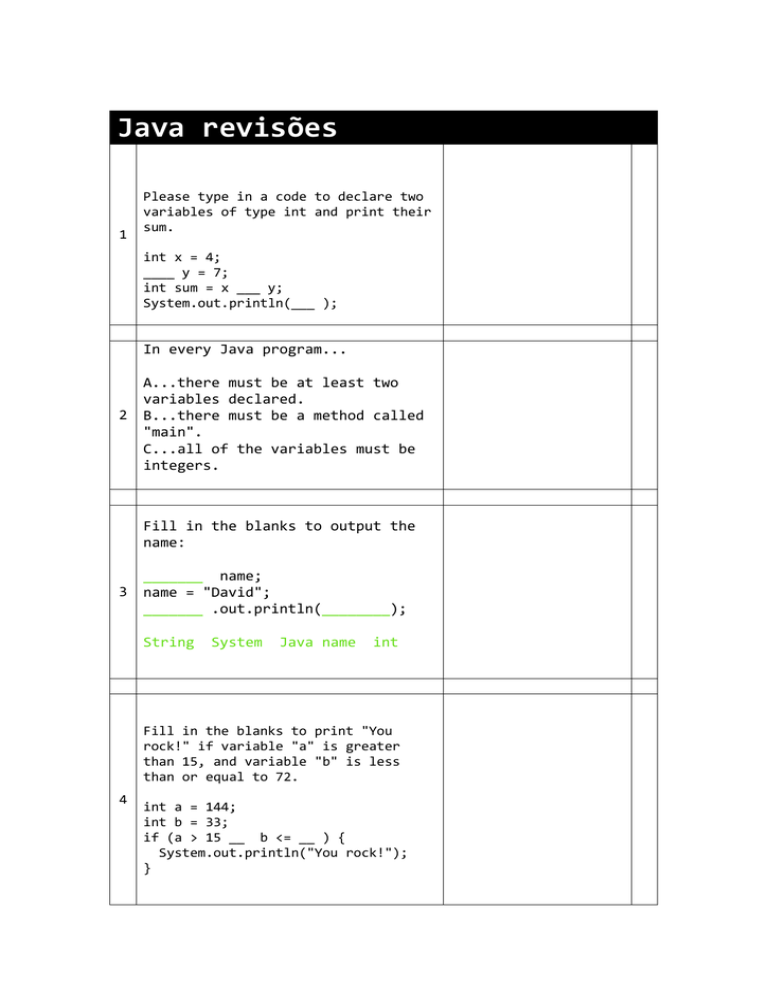
Java revisões
1
Please type in a code to declare two
variables of type int and print their
sum.
int x = 4;
____ y = 7;
int sum = x ___ y;
System.out.println(___ );
In every Java program...
2
A...there must be at least two
variables declared.
B...there must be a method called
"main".
C...all of the variables must be
integers.
Fill in the blanks to output the
name:
3
_______ name;
name = "David";
_______ .out.println(________);
String
System
Java name
int
Fill in the blanks to print "You
rock!" if variable "a" is greater
than 15, and variable "b" is less
than or equal to 72.
4
int a = 144;
int b = 33;
if (a > 15 __ b <= __ ) {
System.out.println("You rock!");
}
Fill in the blanks to print "in a
loop" 7 times, using the while loop.
5
int x = 1;
while (x <= ___) {
System.out.println("in a loop");
___++;
}
Please select the correct statements
about && and || operators.
6
Select all that apply
a)
a && b is false if both a and
b are true
b)
(a || b ) && c is true if c is
true and either a or b is true
c)
a && b is true if either a or
b is true
d)
a || b is true if either a or b
is true
6.1. Cria uma tabela com os
operadores relacionais e lógicos
utilizados na linguagem JAVA
7
What is the output of this code?
int arr[ ] = new int[3];
for (int i = 0; i < 3; i++) {
arr[i] = i;
}
int res = arr[0] + arr[2];
System.out.println(res);
Fill in the blanks to print "in a
loop" 5 times using the for loop.
8
9
___ (int x = 0; ___< 5;
x++) {
System.out.println("in a loop");
What is the output of this code?
int result = 0;
for (int i = 0; i < 5; i++) {
if (i == 3) {
result += 10;
} else {
result += i;
}
}
System.out.println(result);
Classes and Objects Object-Oriented Programming
POO (programação orientada a objetos) é uma ideia
que vê o objeto como uma parte de um programa (como
se fossem vários mini programas que juntos fazem um
programa).
Object-Orientation
Pergunta C1
A class
defines...
(choose two)
Select all that
apply
a) values
b) objects
c) attributes
d) behavior
Class – é planta (o projeto da casa mas não é a
casa em si)
A
class
é a Object-Oriented
ideia e o objeto é aProgramming
coisa em si
Java
uses
Conceito1:
Podemos
fazer
várias
casas
com
(OOP), a programming style that (objetos)
is intended
base numa planta (class)
to
make thinking
closer
Conceito2:
Não serve about
de nadaprogramming
criar uma planta
to
thinking
world.
(class)
se não about
se vai the
fazerreal
uma casa(objeto)
In OOP, each object is an independent unit
with
a define
uniqueosidentity,
as objects
A
class
Atribute e just
Behaviour
– Se se in
trata-se
uma pessoa
the realdeworld
are. (Atributos – Sexo; idade;
altura)
– correr;
An apple (Behavior
is an object;
soandar;
is a saltar)
mug. Each
has its unique identity. It's possible to
have two mugs that look identical, but they
are still separate, unique objects.
Objects also have characteristics, which
are used to describe them.
For example, a car can be red or blue, a
mug can be full or empty, and so on. These
characteristics are also called attributes.
An attribute describes the current state of
an object.
In the real world, each object behaves in
its
own
way. The car moves, the phone rings, and so
on.
The same applies to objects: behavior is
specific to the object's type.
In summary, in object oriented programming,
each object has three dimensions: identity,
attributes, and behavior.
Attributes describe the object's current
state, and what the object is capable of
doing is demonstrated through the object's
behavior.
Classes
A class describes what the object will be,
but is separate from the object itself.
In other words, classes can be described as
blueprints, descriptions, or definitions
for an object. You can use the same class
as a blueprint for creating multiple
objects. The first step is to define the
class, which then becomes a blueprint for
object creation.
Each class has a name, and each is used to
define attributes and behavior.
Some examples of attributes and behavior:
Classes and Objects
Methods
Methods
Pergunta M1
Methods define behavior. A
Fill in the blanks to call
method is a collection of
the method "hello" from
statements that are grouped
main:
together to perform an
public static void
main(String[ ] args) {
______________;
}
static void hello() {
System.out.println("hi");
}
operation.
System.out.println() is an
example of a method.
You can define your own
methods to perform your
desired tasks.
Let's consider the following
code:
class MyClass {
package aulascon;
class Minhaclass {
static void dizola() {
System.out.println("OLÁ
mundo!");
}
public static void
main(String[ ] args) {
dizola();
}
}
The code above declares a
method called "sayHello",
which prints a text, and then
gets called in main.
To call a method, type its
name and then follow the name
with a set of parentheses.
Pergunta M2
How many times can you call a
method?
a) one
b) only two
c) as many as you want
Calling
Methods
You can call a method as many
times as necessary.
When a method runs, the code
jumps down to where the
method is defined, executes
the code inside of it, then
goes back and proceeds to the
next line.
Example:
package aulascon;
class Minhaclass {
static void dizola() {
//Criação do Método dizola
System.out.println("OLÁ
mundo!");
//Criação do
Método dizola
}
public static void
main(String[ ] args) {
dizola();
//Chamada
do Método dizola
dizola();
//Chamada
do Método dizola
dizola();
dizola();
dizola();
}
}
Pergunta M3
What output results from this
code?
public static void
main(String[ ] args) {
doSomething(4);
}
static void doSomething(int
x) {
System.out.println(x*x);
}
Method
Parameters
You can also create a method
that takes some data, called
parameters, along with it
when you call it. Write
parameters within the
method's parentheses.
For example, we can modify
our sayHello() method to take
and output a String
parameter.
class MyClass {
package aulascon;
class Minhaclass {
static void dizola(String
nome) {
System.out.println("OLÁ
mundo!"+nome);
}
public static void
main(String[ ] args) {
dizola("Rui");
dizola("Ana");
}
}
The method above takes a
String called name as a
parameter, which is used in
the method's body. Then, when
calling the method, we pass
the parameter's value inside
the parentheses.
Methods can take multiple,
comma-separated parameters.
The advantages of using
methods instead of simple
statements include the
following:
- code reuse: You can write a
method once, and use it
multiple times, without
having to rewrite the code
each time.
- parameters: Based on the
parameters passed in, methods
can perform various actions.

